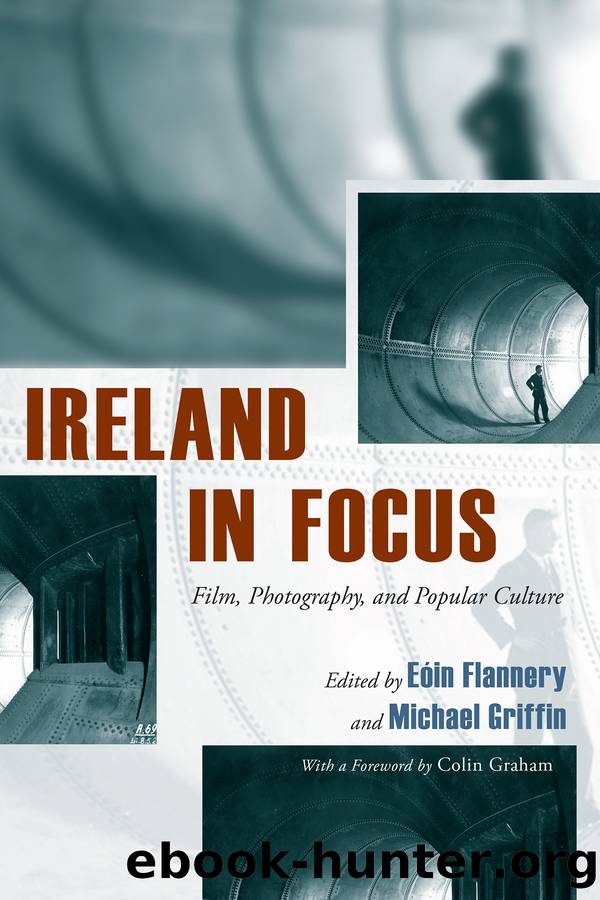Ireland in Focus by Flannery Eóin;Griffin Michael;Flannery Eóin;

Author:Flannery, Eóin;Griffin, Michael;Flannery, Eóin;
Language: eng
Format: epub
Publisher: Syracuse University Press
Published: 2021-07-22T00:00:00+00:00
The bogâs connection with the folklore and mythology of Irelandâs coastal west has in large part dictated its visual and literary constructions. The artist, or even the Nationalist, who seeks either an imaginative or political muse is, of course, drawn to a land that preserves the past through its connection to ancient story and legend. As a result, narrative scripts of the landscape neglect the less romantic connection of working farmer to turf. In many ways, Gieseâs photography of the Donegal bog rewrites this script, as well as the work of the turf cutters who labor for access to what the bog land is willing to provide for them.
The Oxford Irish dictionary records the Irish word for sod as fód or fód móna, indicating a sod of turf or layers of turf; likewise an fód dúchais means oneâs native place. These simple linguistic turns indicate an understanding of the material earth that involves both geological layers and their formation of a human sense of origin. A linguistic mapping of the Irish word for earth is perhaps mirrored in the processes involved in its material excavation, and it is with these processes Gieseâs photography is concerned. âDrying Turf in Springâ contrasts the soft bog cotton and captures a small stream against the gritty density of an anomalous spring image and âTurf Bankâ offers a subtle shift of perspective in its framing of a light-touched turf field (Figures 6.3 and 6.4).
Smooth edges of the broken turf pieces lie in contrast to the rough grass of the bogland, the wall of the bank traveling to the edge of the frame, its pattern of lines revealing years of settling earth. Although these two photographs construct an image of turf as a still collage of angled sod and thicket bog, this visual impression is not left untouched. Giese illustrates an excavational human engagement with this earth, as turf cutters work against the natural processes of the bog to transform it into a usable source of fuel. âTaking out the Turfâ captures an arduous moment in this transformation (Figure 6.5). A spadeâs blade is deep within the turf, its handle pushed by a person whose presence is only made known by the toe of a mud-covered Wellington boot and the slant of a shovelâs handle. Another manâs action becomes the most clear indication this is a labored land, his fingers deeply entrenched into the moist turf, the veins raised from beneath the skin of his forearm, his knuckles white with strain.7 The manâs physical embrace of the sod is clear in his face as well, eyes focused down, the flex of his face muscles suggesting gritted teeth. He stands within the sod; his feet follow the path the spade crafts, and his strained back brings him closer to the sod he takes. In addition to augmenting the photographâs emphasis on active work, the title given to this photograph positions the action in relation to the material earth. The sod is not just taken, it is taken âoutâ of something; it is taken away from its larger source.
Download
This site does not store any files on its server. We only index and link to content provided by other sites. Please contact the content providers to delete copyright contents if any and email us, we'll remove relevant links or contents immediately.
Shoot Sexy by Ryan Armbrust(17659)
Portrait Mastery in Black & White: Learn the Signature Style of a Legendary Photographer by Tim Kelly(16953)
Adobe Camera Raw For Digital Photographers Only by Rob Sheppard(16906)
Photographically Speaking: A Deeper Look at Creating Stronger Images (Eva Spring's Library) by David duChemin(16623)
Bombshells: Glamour Girls of a Lifetime by Sullivan Steve(13977)
Art Nude Photography Explained: How to Photograph and Understand Great Art Nude Images by Simon Walden(12975)
Perfect Rhythm by Jae(5326)
Pillow Thoughts by Courtney Peppernell(4211)
The Book of Joy by Dalai Lama(3903)
Good by S. Walden(3488)
The Pixar Touch by David A. Price(3364)
A Dictionary of Sociology by Unknown(3031)
Fantastic Beasts: The Crimes of Grindelwald by J. K. Rowling(2995)
Humans of New York by Brandon Stanton(2835)
Stacked Decks by The Rotenberg Collection(2812)
Read This If You Want to Take Great Photographs by Carroll Henry(2664)
On Photography by Susan Sontag(2576)
Insomniac City by Bill Hayes(2499)
Photographic Guide to the Birds of Indonesia by Strange Morten;(2490)
